#mongolian secret history
Explore tagged Tumblr posts
Text

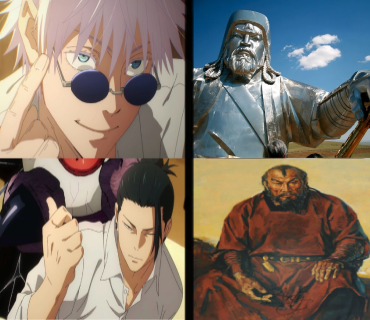
#history#world history#gengis khan#jamukha#gojo satoru#geto suguru#literally them#jjk#mongolian secret history
20 notes
·
View notes
Text
Shadow's past (without Black Doom) - yeah talking about the original Shadow again.

BD is an afterthough (Shadow was not supposed to be an alien) and it is what had slowly made Shadow too over the top and outlandish.
in SA2 Shadow's past (originally it was supposed to be Sonic's past too but only few things of the original idea remained there) is more pleasantly eerie. We don't really get to know who is Maria, nor her role aside being Shadow's friend and Shadow's creation is more mysterious (and way more balanced and way less convoluted)
We have little information about who Maria was - aside being brave - But it was clear by their little speech that Shadow was completely open to her, letting his thoughs run freely without reservation, completely trusting her.
Shadow was melancholic as usual, I wonder where the idea he used to be all blubby and cheerful comes from. Although OG Shadow had few cheerful moments, melancholy is one of his most prominent personality traits.

No hate on you, starfish...
It was not clear what was Shadow's purpose (Shadow himself was unsure). It was said he was created in order to discover the secret of immortality. He was also weaponized later, but he wasn't born as a weapon. And following SA2 story, it turns out clear.
Shadow weapon qualities in SA2
His mind: his best cards actually

Love this excited Shadow. So rare.
They mentioned the QI (numbers) of only three characters in Sonic: Eggman, Tails and Shadow, all gifted.
Shadow enjoyed reflecting on life when alone, and he liked to use his brain when in action. In fact, in SA2 he doesn't fail at all, his plan is so flawless, it is a complete success. It was terminated simply because it was leading to a disaster (Shadow was aware of this, he just changed his mind), but you can't deny that, unlike Eggman who does a lot of mistakes due to his ego and temper, Shadow know how to get stuffs done.
To underline his intelligence, during the game Shadow caused minimal destruction, virtually any on his own (the bomb was an Eggman idea - not surprise). In the note leading to Shadow's creation, he was supposed to be 'like a ninja' and is known ninja love to keep a low profile. So less noise, the better.
In previous topic (still in my blog) I mentioned Shadow's successfully manipulating a psychopath like Eggman (psychopaths are great manipulators if they are intelligent enough). Most notably, Shadow is not a psychopath, was not trained and is a kid.
In addition, just like Sonic always like to move around and hate to stay still, Shadow liked to keep his brain occupied in some way. Even simply studying 'Blue' (not 'Faker') and questioning him, he enjoyed that.
Hil cool-headedness is linked to his intelligence, I think.
Actually, I believe intelligence was his best quality.
Modern Shadow lacks of the brain and patience to set a perfect plan on his own before taking action. He is more a brawler and I don't perceive him to be particularly intelligent. Such little satisfaction :(
We think to wars as mayhem and bombs and rifle, bazooka, etc...
In history there have been small armies who won far bigger armies in no time, and this happened more than once. How did they do? Well, mostly with a well crafted plan and you need brain for this. Gengis Khan and the Mongolians were a good example of this.
I follow a site about knowledge on various topics and among those who write there, there are also soldiers. Sometimes they explain what war is like, and is anything like Call of Duty.
Speed

I always figured that Shadow's speed is helped by his shoes, since SA2. Shadow moves less (this also underlines his calmer personaity I think), sparing his energies, most likely because he has less energies than Sonic.
However his speed is more than enough for stealth and he was stealthy.
In a war enviroment this would be super useful, he can avoid the dangers, the bullets and would be hard to be seen and detected.
Athletic qualities

Same as Sonic. And counter balanced. Shadow might be not as fast as Sonic without his shoes, but he can swim, no problem, unlike Sonic that just sink like a rock. That would allow to go where is needed with no limits (is unfortunate games never use character swimming abilities, unless they're not Knuckles, Rouge or Tails). He is also strong.
Urge to save people, regardless (gone in recent characterizations).

Although recently it was stated he only look at the big picture (preserve the planet), Shadow originally cared for people. And from SA2 it seems that characteristic is drilled in him. Because when Rouge is in danger, he doesn't want to save her at first. But this simple choices became visibly painful for him, he struggled and quikly got to her rescue.
In Sonic Heroes he was amnesiac and saved Rouge from Omega without thinking. Rouge was a stranger to him and he rushed almost like he could not do anything different. Everytime he rush to save someone, is amost like an invisible force leads him. Possibly he acts this way because he could not save Maria. In Sonic 06 is him who attempst to assist Elise's father. Not the nice, extroverted Silver. The wary, introverted Shadow rush to cheek.
In war you should be able to save your allies when they're hurt but not dying. You can also be part of the medical staff if not a soldier.
Unique talents

Chaos Control, Chaos Spear and Chaos Blast. No need of some Sauron eyed starfish for those abilities. Chaos energy is what keeps Shadow alive and also what make him immortal (a curse for him actually).
Shadow himself stated that he can bend time and space and uses the chaos control to teleport, but he can also teleport other things instead of himself, including large objects. He can also stop time. in Sonic 06 he travels through time, but he needs help to open portals.
I remember when I played SA2 first, i found scary that somebody could throw a spear from afar or paralyze you. Eggman could not. Eggman badnicks threw falfunctioning missile. But Shadow had an immense power and was perfectly in control, and he was calmer than Sonic, not somebody who could lose his head easily.
The rings he wears symbolize his lack of freedom, they also function as restraing Shadow's real power. If he removes them he becomes powerful, virtually invincible. And things would turn very ugly.
All that is self explanatory.
Drawbacks

This art belong to the.shadamy.artisto10. Video to Crazy Greg
A good, balanced characters (who doesn't have a loomy floating starfish over his head) has strenght but also weakness. OG Shadow's weakness are as large as his strenghts.
Physically not so tough

SA2, after we saw a good display of Shadow's strenght, after he won, Amy convinced him to join the good side. Shadow defeated the biolizard without difficulty. But then he joined Sonic to defeat the Biolizard again, who fused with the ARK.
Shadow and Sonic togheter defeated the beast, but well, we all know what happened to Shadow. Because of all the music (aswell as the iconic quietness of Shadow's voice), Shadow's death was so sudden and shocking. But if you remove the music, you hear he is breathless, while Sonic is still healthy. I think is the set back of the very same power that keeps him alive. With so much chaos energy, his limiters (or inibitor rings) become useless.
Inibitor rings or limiters
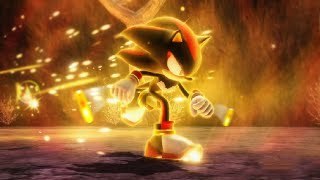
Shadow's power is so dangerous for him too that he uses it so rarely and is not virtual.
While in Sonic X and in Archie comics, we see what happens if Shadow doesn't wear them, the only time in the game he removes then is Sonic 06. And after he finish, he quickly wears them again so you clearly see he needs them, desperately.
Eggman describled this power like a 'furnace', so I imagine shadow gets a really bad fever if he doesn't wear his ring, after a first explosion of power.
Recurring - emotionally vulnerable

Shadow is always considered overly confident.
That is what he shows to his foes, but his view on himself is quite harsh, even self loathing, with lots of suicidal thoughs. That's his melancholy taking place and nothing can be done against it, only hoping for better moments (Sonic 06 shows a more confident Shadow). It is shown in Sonic Battle, Archie Comics, Shadow the Hedgehog and recent materials.
While, at least in the original characterization, he wasn't nearly as grumpy as Sonic, it was easy to hurt him deeply.
Shadow shows a lot of coping mechanism at the slighlest perception of danger, his favourite is turning his back towars his peers, often slouching, trying to hide as much as he can. Avoiding eye contact is another of his favourite and the most obvious. Shutting off completely (less frequent. In Sonic Battle he goes mute for a long time, Rouge talks for him). Glaring and throwing death treats that fall flat.
Ultimately, the fact he was not born as a weapon is clear in games like Sonic Battle, where he clearly despise wars, building of weapons and so on. If he was meant to be a weapon, he should have been more reckless, joyful and would have enjoyed war or being destructive. Sort of IDW Shadow but with a perpetual grin.
All good stuffs without Black Doom!
Those are the original notes for Shadow and i think they describle the original Shadow very well. The 'Vegeta' thing appears to be more a reference than 'make him identical to Vegeta'. But is clear where his personaity comes from. I shared the French ones too. French is the closest language to Italian, the grammar rules are the same. Spanish is a cauldron of false friends and is not so familiar.



My brother said he is like Vegeta, but softer.
#shadow the hedgehog#sonic the hedgehog#sonic#shadow#sonic adventure 2#sa2#original shadow the hedgehog
33 notes
·
View notes
Text
The Big Pent Collection Post: Secret History of the Horse Sun
It has been pointed out to me that I haven't actually ever written a post explaining what the hell Secret History of the Horse Sun is. So, uh, doing that now!
The Fuck's A Glorantha
Glorantha is a TTRPG setting attached to one of several rulesets for the games Runequest, HeroQuest, QuestWorlds or other names which I've probably forgotten. It is a vaguely Bronze Age-ish world focused around religious fantasy and spiritual power rather than traditional medieval stuff, as it was designed by anthropologist and practicing shaman Greg Stafford. I think it's pretty cool! But it is largely focused on an area named Dragon Pass, where a bunch of guys called the Orlanthi live. They're a mix of Vedic, Celtic and Norse ideas thrown into a stewpot, and they're cool and all...but there's other regions, and not all of them are particularly well written.
Like Pent
Pent is a very large steppes plain - somewhat larger than the entire nation of France, maybe five or six times bigger than Dragon Pass - which goes criminally underused by Glorantha. It exists solely as a place for horse nomads to rampage out of and threaten the people the game actually cares about, and as an origin point for historic figure Sheng Seleris, mighty warlord who conquered the Celestial Empire of Kralorela (read: Not China, generally poorly written) and almost destroyed the Lunar Empire (the primary villain nation of mainline Glorantha these days) before the Lunars defeated him and imprisoned him alive in the depths of Tax Hell.
Pent is a grassland steppe vaguely based on Mongolia and Sheng Seleris is vaguely based on Temujin, the Chinggis Khan. This is an area of IRL history and culture that deeply fascinates me and which I love reading and talking about. So I looked at Pent and its generally boring or outright bad writing and decided it needed to be done better.
As such, I started Secret History of the Horse Sun, a total rewrite of Pent as a location and culture. It is heavily based on Mongolian, Tibetan and Central Asian Turkic cultures, backed by my academic research on these areas but very much fictionalized and changed to fit the world of Glorantha and its preexisting mythos. This work is not an accurate representation of real world Mongolia, Tibet, Kazakhstan, Kyrgyzstan, ancient Scythia or anywhere else on Earth, though it is my goal to be as respectful of these real world places and peoples as I can be in my portrayal of a fictional culture similar to them.
This post is intended to collect my work on the project into a way that is easy to understand, read, and link to. Below, posts will be divided up into categories based on what they're about. If anything confuses you, please feel free to comment or send an ask or whatever - I love talking about my work and am happy to explain stuff.
The actual work is set shortly before the rise of Sheng Seleris, as I think this is the most interesting time for Pent; it has retconned a number of details to make things more interesting for me, though, like the Winds being gods despite it being pre-Sheng. I will eventually be writing a guide to adventuring before and during Sheng's rise.
Eventually.
The Pentan Gods
The first part of the project was a writeup of the Pentan pantheon, a group collectively known to the Pentans as the First Herd. These are writeups in the HeroQuest 2e/QuestWorlds system, and are mechanically usable in that system, but because the mechanics are highly narrative and descriptive, each writeup is also a description of the god and their cult within Pentan society; in Glorantha, religious cults form much of the bedrock of all societies.
Yu-Kargzant, the Sun Khan, God Above Gods
Basko, the God of the Bad Death, Lord of the Dark Shamans
Dostal, the God of Bow Hunting
DuTukhos and Arcos, the Gods of the Arcos River
East Sting Wind, the God of Bandits and Crime
Erissa, the Goddess of Healing
Eyritha, the Herd Mother, Goddess of Herd Animals That Aren't Horses or Sheep
Galana, the Chooser of Khans, Goddess of Horses
Golden Bow, the God of the Good Death, Lord of the Bright Shamans
Gor Gorma, the Goddess of Terror, the Malign Earth, and Vengeance
Hurfor, the God of Secrets and Law
Hyalor and Gamari, Man and Horse, the Good Ancestors
Issaries, the God of Trade and Mules
Kargzant, the Light Khan
Lozarl, the God of Impure Fires, Mining, Labor and Asses
Manurl, the God of Cats and Trapping
North War Wind, the God of Death
Oria, the Goddess of Earth
Pole Star, the God of Strategy and Warfare
Samnal, the Bad Ancestor, God of What Not To Do
South Rage Wind, the Storm Bull and Chaos Killer
Sirdaryo, Goddess of Wrestling and the River Sirdaryo
Tarhel and Heltar, the Gods of Sheep, Clouds and Weaving
Tepekos, the God of Smiths
Tholm, the God of Falconry
West King Wind, the Storm Khan
Whirlwind Fool, Raven, and other Tricksters
Elyu-Ene, the Emissary of the Winter Gods
Pentan Cultural Overview
This collection of posts was written to try and provide a broader understanding of Pentan culture as it exists without wholly being about the religion. While religion permeates every aspect of Pentan life (and Gloranthan existence in general), there is life outside of the gods, after all.
Horses
Age
The Ancestral Peoples of Pent
Food and Daily Life
Fashion
Law
Love and Hatred
Slavery (CW, uh, Slavery)
Sports
Warfare
Non-Pentan Peoples
The Khuruldan
Life from the Pure Horse Perspective
Life from the Kargzanti Perspective
Life from the Four Winds Perspective
Hsunchen and Qa Ying
After I finished the above, I decided I needed to properly detail the non-Pentan cultures in and immediately around Pent. The first grouping I began to work on were the Hsunchen of the Shan Shan mountain range east of the Pentan plains. The Hsunchen are a type of person in Glorantha - "beast people," human beings who are able to transform into animals due to their worship of ancestral beast gods and spirits. Within the Pentan area they are not considered to be human, either by themselves or their neighbors, and could broadly be compared to werewolves, werebears, etc. They are largely non-agricultural, often viewing intensive agriculture as a violent assault on the living earth, and have societies roughly based on the animals they consider to be their kin. The Qa Ying are winged people also called the Wind Children, and are potentially descended from literal winds or are possibly eagle Hsunchen, or a mix of both in the past who became one thing.
The Qa Ying
King Violent Wind, God of Rulership and Storms
Merciful Rain Consort, God of Clouds and Water
Inner Wind Sage, Spirit King of the Wind Spirits
Blazing Wings Hunter, God of Hunting and Ancestral Raptor God
The Lo Fak Yak Folk
Lo Fa, Ancestral Yak Goddess of the Lo Fak
Undrung, God of Draconic Mysticism and Seeker of Mystic Truths
Yi Da, Spirit Yak and God of Shamans
The Lo Fak also worship their own version of Storm Bull but I didn't do a full writeup because he's very similar.
The Chen Ga Snow Leopard Folk
Chen Gar, Ancestral Snow Leopard God of the Chen Ga
Freezing Wind, God of Winter
Snow Woman, Goddess of Mountain Peaks
The Hsa Tiger Folk
Hsa Black Stripe, Ancestral Tiger God of the Hsa
Yumaryu, the God of Light and the Sun Spear Man
Gods of the Cat Brothers, Shared by the Hsa and Chen Ga
Bieti, the Mountain Witch and Patron of Shamans
Sakkar Swordtooth, God of Fear and Hunger
The Ri Si Woodpecker Folk
Ri-si, Ancestral Woodpecker Goddess of the Ri Si
Cucul, Cuckoo God of Shamans
The Orathorn
The Orathorn are the only real sorcerous group in Pent - a small order of necromancers led by the immortal sage Orathorn, granted an imitation of immortality by his magic. They seek the conquest of Death, hoping to grant immortality to all humanity, that they might be free to pursue their true power and goals rather than be bound to what the Orathorn see as slavery-in-afterlife to gods in exchange for power within a paltry mortal lifespan. Most Pentans consider them horrible monsters for, among other things, their casual use of undead, their casual blasphemy, and their terrifying power...insofar as most Pentans ever deal with them, anyway. They are still sometimes hired as mercenaries by those Pentans who are less concerned by prohibitions on the use of sorcery, and they believe their selflessness will be vindicated...eventually.
Orathorn Overview
Principles of Sorcery and the Sorcery of the Zaburi
#glorantha#gloranthaposting#pent#rpg#secret history of the horse sun#heroquest#questworlds#pentan cultural overview
16 notes
·
View notes
Text


If you are still heart broken about the destruction of the Alexandria library, you will be happy to hear in a far away world, there’s a vast library hidden from the world for centuries, contains 84,000 books, which are planned to be digitised, translated and share with the world.
The Sakya Monastery in Tibet, founded in 1073 by Khon Konchog Gyalpo, is renowned for its vast library of ancient manuscripts, many of which remain untouched for centuries.
Most of these texts are Buddhist scriptures, meticulously handwritten in various languages like Chinese, Tibetan, Mongolian, and Sanskrit. But the depth of this collection is vast. It isn’t limited to religious teachings; it expands into the realms of literature, history, philosophy, the stars above with astronomy, the logic of mathematics, the beauty of art, and even the practical wisdom of agriculture.
The scale of this library is staggering. Picture traditional bookshelves stretching 200 feet and soaring to 33 feet, all packed with a whopping 84,000 books! Among these, there’s a standout: a single scripture that tips the scales at a massive 1,100 pounds, claiming the title of the heaviest in the world. Thanks to the region’s dry climate, the library also boasts a collection of delicate palm-leaf manuscripts, preserved in near-perfect condition.
The library is not open to the general public but is accessible to members and visiting scholars with permission. Efforts are underway to digitize these manuscripts, making them more widely available for research and study. This initiative highlights the library's role as a bridge between ancient wisdom and modern scholarship, offering invaluable insights into Tibetan culture and knowledge.
Now, these precious papers give us a peek into Tibet’s history. They show us how people lived, what they believed, and how they dreamed. Thanks to the Sakya Monastery, a whole world has been brought back to life from long ago. Everyone can learn and be amazed by the wonders of the past.
[Sources]:
*Earthly Mission: Tibet's Great Sakya Library (https://earthlymission.com/tibet-great-sakya-library-84000-scrolls-heaviest-scripture-world/)
*History Enhanced: Unveiling the Unseen (https://historyenhanced.com/unveiling-the-unseen-84000-unread-manuscripts-from-sakya-librarys-timeless-tales-discovered/)
*The Historians: The Secrets of Sakya Monastery Library (https://thehistorians.org/2023/12/24/the_secrets_of_sakya_monastery_library_in_tibet/)




#Tibet#Sakya Monastery#Khon Konchog Gyalpo#Ancient manuscripts#Buddhist scriptures#Mongolian#Sanskrit#Chinese#Tibetan#Religious Teachings#Arts#ancient literature#ancient history#ancient philosophy#astronomy#ancient agriculture#ancient wisdom#ancient library#heaviest book in the world
29 notes
·
View notes
Note
So, you have spoken about the benefits of reading primary sources from various cultures, right? but you also don't speak a second language fluently? I agree with you I think about the benefits of a first-hand view of perspectives from a range of cultures, but I am (naively) skeptical of the ability of translation to capture the subtleties that make this interesting, so my question is twofold:
How do you avoid/approach this problem?
Which documents would you recommend as most enlightening?
My advice is as always "if you're really truly serious, you have to learn the language". Like I think it's correct that when it comes to the subtleties, translation just doesn't cut it (even though, in broad strokes, anything can basically be translated into any language). So the answer is "learn the language". Unfortunately this is a huge amount of time and effort. If you're lucky, such as me, you just like language learning anyway so it's fun.
With respect to not speaking a foreign language fluently: "fluency" is a word that gets thrown around a lot, but the reality is that language learning is a continuous process, and there is (for the second-language learner at least) really no binary moment of "fluency", only greater and lesser levels of competence. Obviously my competence in Japanese is not nearly as high as I aspire for it to eventually be, but it very much is enough to read various things, communicate with people, make jokes... basically get non-trivial access to the culture. So, that's one answer!
The other answer is "translated sources are imperfect, but you just gotta make due. Prefer a scholarly translation if you can get your hands on it, and have the disposition to use it wisely". I am currently (at a glacial pace) making my way through de Rachewiltz's massive tome of a translation of The Secret History of the Mongols. In theory I'd love to be read it in Mongolian, and if I ever acquire the mythical full-time language learner job, maybe I'll learn Mongolian and do that. But while my time and so on is limited, I'll make due with the translation.
Uh I hope this answers your question!
16 notes
·
View notes
Text
Naadam - and how Mongolia celebrates it.
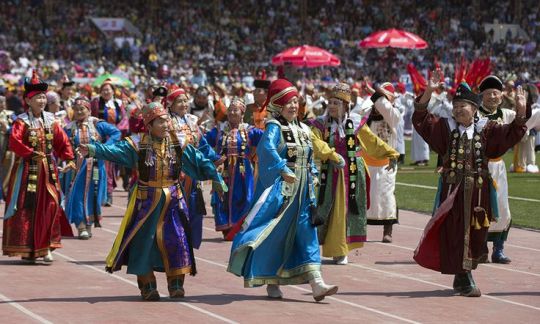
What is Naadam in Mongolian culture and how would Mr Mongolia celebrate it?
Naadam is a traditional sports festival in Mongolia. It includes Mongols adorning themselves in national dress, mounted soldiers in uniform, music, dancers, and of course, the "Three Manly Sports":
Horse riding, wrestling and archery!
Naadam is a 2000 year old event, however, the term "Naadam" was coined in the 13th century by Chinggis Khaan (according to the secret history of the Mongols) and has been celebrated ever since.
Naadam used to be a preparation/practices/training for war. Competitions such as this would take place just before major battles in order for the war commanders to select which soldiers would be in which division.
Individuals who demonstrated exceptional strength, speed, and flexibility in wrestling, keen eyesight and precise hand-orientation in spear-throwing and archery, and also patience and skill in horse training/horse racing were carefully selected during the competitions.
Naadam takes place around mid-July in the heat of the summer, and is considered one of the biggest and most important festivals in Mongol culture along with Tsaagan Sar.
National Naadam is celebrated in the capital - Ulaanbaatar, in the national sports stadium. However it's not just restricted to the city! It takes place all across the country.
The Naadam festival kicks off with a ceremonial transfer of the symbolic "Nine Banners of the Great Mongol Empire" from the Government House to the Naadam stadium, escorted by honorary guards.
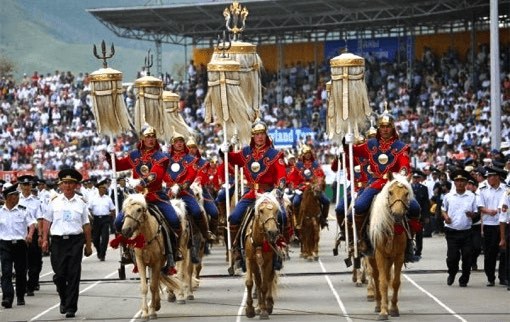
After a speech by the president or a representative, the games officially commence. In Ulaanbaatar, the capital, the event assumes a grand scale, drawing the most talented wrestlers, horse trainers, and archers from all corners of Mongolia!
As I've previously mentioned, Naadam takes place in the countryside too! In the countryside, herders journey to towns not only to partake in the festivities but also to reunite with friends and relatives, they may not have seen in a while.
Mongolia also has a bit of a reunion - with different Mongolic ethnic groups and other ethnic groups who's people participate in Naadam coming over to visit. Buryat and Uriankhai people are an example, and they (So, Buryat Mongols, Uriankhai/"forest people" as Mongols call them, usually denoting the likes such as Tuvans and Yakuts) have their own archery competitions. It's basically like one big get together!
Wrestling
Mongolian wrestling has no time limit and one objective - avoid touching the ground with anything other than your feet, or else you lose the match.
It also has no weight classes!
The National Wrestling Championship takes place during Naadam , however even before this, there are previous stages.
First is Soum (village) Naadam. Soum Naadam showcases wrestlers from various villages vying for the opportunity to represent their respective villages at the regional level.
Wrestlers who win at the Soum Naadam progress to the Aimag (province) Naadam, where they contend against other wrestlers within their own province to win the opportunity to represent the province.
The ultimate challenge awaits the winner of the Aimag Naadam at the National Naadam in Ulaanbaatar, the grandest and final tournament. Here, the aimag representatives vie for the prestigious title of national champion!


Mongol wrestling painting, 16th century
I definitely think Mr Mongolia is an avid wrestler/quite sporty himself (jock™) however he is a nation and so his nation strength and... Many, many years of experience would mean that it would be unfair for the most part if he went against humans. And besides, he absolutely risks outing himself if he participated in Naadam, especially with how popular wrestling is and uhh, considering the wrestling outfits... The lack of anonymity with that comes with it hahah.
However I think he participates in his own way. I think occasionally he helps with being with being a referee. Another thing: music. During Mongol national wrestling matches, you can often hear someone singing a Mongolian long song in the background. A long song is well, a song, which doesn't actually have a lot of words, but the the words are drawn out by the singer and emphasis is put on reaching impressive notes and putting power and volume in the voice. I think he does musical performances during naadam!
Archery
The Mongols are famous for their archery. There are many different types of Mongol archery.
There's Khalkha Archery, the most practiced one (seeing as the Khalkha Mongols are the majority ethnic group in Mongolia), spanning across a remarkable duration of 48 hours.
Those who triumph in this contest earn the esteemed distinction of the state archery title.
There's also women's archery! As for the women's archery tournament, they display their prowess by releasing 20 arrows towards a 60-meter target, while their male counterparts take aim with 40 arrows at a distance of 75 meters. The target itself comprises a symmetrical arrangement of diminutive leather cylinders, artfully positioned in rows of two and three.
Two red cylinders occupy the center of the target, but hitting them doesn't earn extra points. Each hit on a target gives one point, but merely hitting isn't enough for a score. The target must move a set distance from its starting point to count towards the final score.
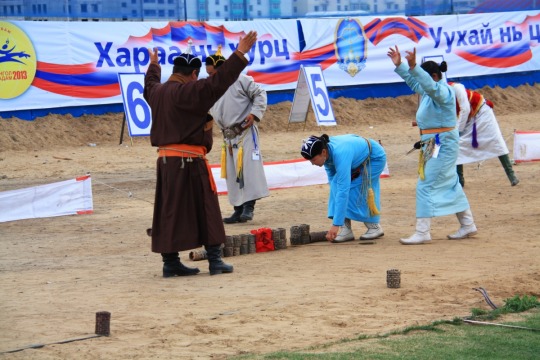
There's also Uriankhai archery and Buryat archery - with Uriankhai archery only being practiced by men, and is practiced by the Uriankhai ethnic groups (this is a name Mongols give to what they consider Northern "forest people" like Tuvans or Yakuts). It has ties to religious ceremonies related to their culture. Buryat archery is practiced by the Buryat minority ethnic group of Mongolia. Both of which take place during the national Naadam festival.

They even have child archers!
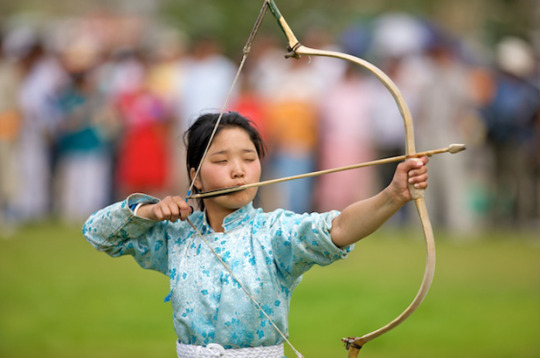
I definitely think Mongolia is very passionate about archery, and watches the archery competitions intently. I think he helps with setting up the targets and prepping some of the archers when he can. He finds it fascinating to watch them display their skills and techniques with such precision and accuracy - and he wishes he could participate himself! He believes it is a testament to the level of dedication and hard work that athletes put into their craft and loves the satisfaction of the perfect hit - he'll always appreciate a good archer. Further, he puts time aside to go and watch the Buryat and Uriankhai archery with Buryatia and the others as its quite important to them all.
Horse racing
Over a thousand horses gather from all corners of the region to partake in this grand event. Diverging from Western traditions, these races traverse immense distances, spanning a remarkable range of 15 to 30 kilometers. The length of each race is intricately tied to the age of the horses, with the seasoned contenders gallantly competing over the longest stretches.

Curiously, the jockeys who guide these horses are not seasoned professionals, but rather children as young as 5 years old, with the oldest among them being 13. Yet, it is the horse's prowess that truly determines the outcome, as the race serves as a testament to their remarkable skills.
Age and gender play crucial roles in the classification of horses within the realm of horse racing. For example, in the case of geldings, they are divided into distinct age groups, spanning from 2 years old up to 6 years and older.
The races commence in a distinctive manner. All the horses gather behind a standard-bearer, cross the finish line together, and then follow the guidance of the official rider to reach the starting line.
In each class, the top 5 performers are crowned as "airgiyn tav," and the top three champions proudly claim gold, silver, and bronze medals. People joyfully sing their praises while showering them with fermented mare's milk (airag) on their rump, neck, and cheek.
The victorious jockey ascends to the esteemed title of "tumny ekh," signifying their leadership over a multitude of ten thousand.
Multiple races are showcased during Naadam. Stallions, specifically those known as Azarga, have a race of their own, while geldings partake in a minimum of three races. Further, a special race is organised specifically for pacing horses in Ulaanbaatar.
Remarkably, even the horse that crosses the finish line last in the two-year-old category is bestowed with a special appellation: "bayan khodood," meaning "full stomach." A heartfelt song resonates through the air, expressing good wishes and luck for the humble competitor to emerge triumphant in the following year.
The subject of child-jockeys seem to be somewhat contested amongst Mongols themselves. I'm not going to touch on that debate, however it should be noted that safety measures have been implemented in order to make sure that the race is as smooth as possible, but I understand that this can be a point of controversy. I definitely think Mongolia does his best in making sure the riders are well prepared/equipped for the races to ensure that have the best chances of coming out uninjured/relatively unscathed as possible. I think he puts extra time and care into this aspect of his Naadam participations considerably. He enjoys it to an extent as it reminds him of when he was a very young horse rider, and he does enjoy the celebrations afterwards, however the safety of the riders is at the forefront of his mind.
Other Naadam headcanons:
-Because Mongols usually wear their best clothes to Naadam, Mongolia definitely does too! He has a different outfit planned for each day.

-He uhh definitely enjoys all the food that's about 🤤 (khuushur, buuz)

-Probably floods his social media with pictures during this time
-Overall, it's quite an exciting yet busy time for him, he is involved in both the preparations for Naadam and participation in some aspects of Naadam, whilst also making sure to keep socialising with all the people he's invited over! But he manages it well.
#hetalia#aph mongolia#hws mongolia#Hetalia Mongolia#hetalia world stars#hetalia world series#hetalia world twinkle#Meta hetalia#Historical hetalia#Aph Buryatia#Hws Buryatia#Hetalia Buryatia#Aph Asia#Hws Asia#Aph east Asia#Hws east Asia#Hetalia east Asia#hetalia headcanons#Hetalia oc#OC: Baatar Batbayar
70 notes
·
View notes
Text
ROUND 1A, MATCH 4
***
WHAT MY PROFESSOR OF MEDIEVAL HISTORY SAID ABOUT THEM
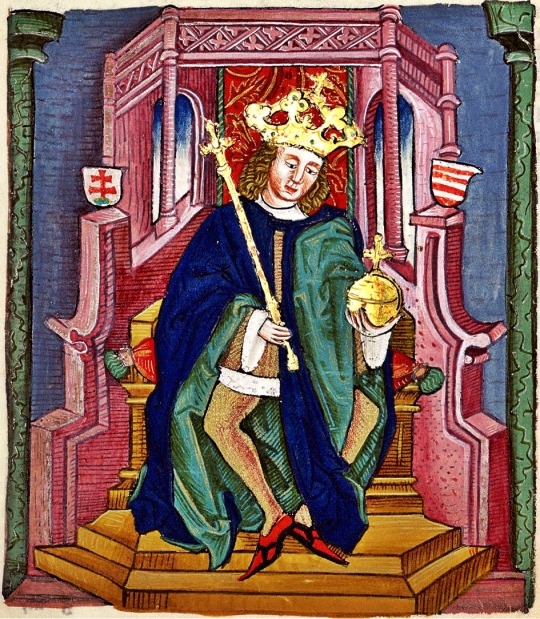
I.Géza (Gejza I.) 1074-1077
dethroned his cousin Salamon and for ONCE an Arpád dynasty member had a good reason for that - that is, Salamon was trying to have him murdered
not technically a king, at least according to the pope, who allied with that little rascal Salamon, but he is the king in our hearts (also Salamon was kicked out of the country, so if Géza made any executive decisions what was HE gonna do?)
in order to keep Salamon away, he consolidated his relations with Byzantine Empire, he even got a snazzy new crown out of it - which was more or less the one you see in the thumbnail (though its history is more complicated)
founder of the Garamszentbenedek (Hronský Beňadik, now in Slovakia) Abbey
he eventually wanted to make peace with Salamon (who again tried to have him MURDERED), but unfortunately he died too soon; after his death, everyone agreed that he was a just ruler and an all around cool dude
he was literally called The Great, but so did the guy he's now against
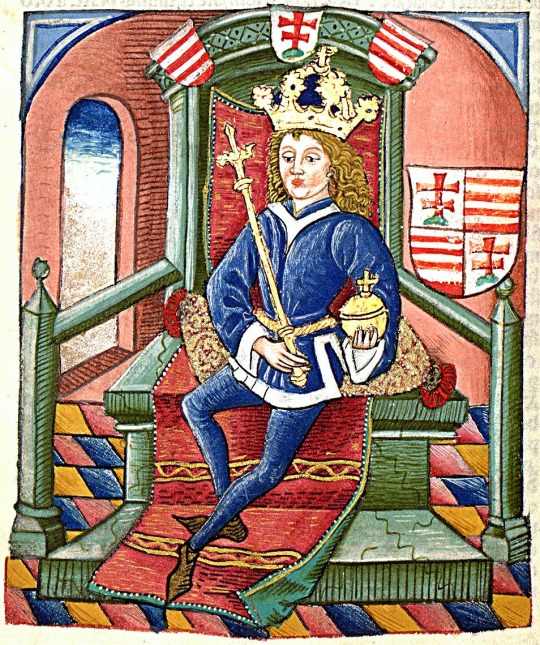
I.Lajos (Ľudovít I.) 1342-1382
ruled for the impressive 40 years and spent 30 of it in war - around Neapolitan succession (don't ask, it's High Middle Ages, Angevins are EVERYWHERE), invasion of Wallachia, against Venice, crusade against Lithuanians, fending off Mongolian invasion of Moldavia
but I guess that's what happens when you have a country at its peak - you can afford to go to wars; to be fair, his dad already took care of the whole "consolidation" part of the process, so he could get into the expansion, during his reign Hungary at its peak extent territorially
founded the first Hungarian university in Pécs
made some minor provisions to the Golden Bull, namely forbidding the kidnapping and forced relocation of peasants by nobility
made important administrative reforms, like founding of the Secret Chancellory
he was also king of Poland, so the Sejm (@rulers-of-poland-tournament) is fully within their rights to tell their side of the story on him
19 notes
·
View notes
Text

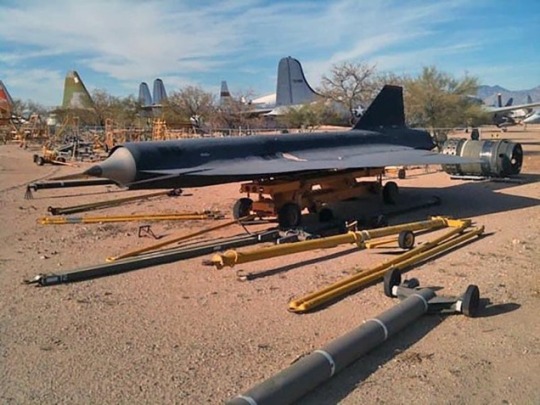
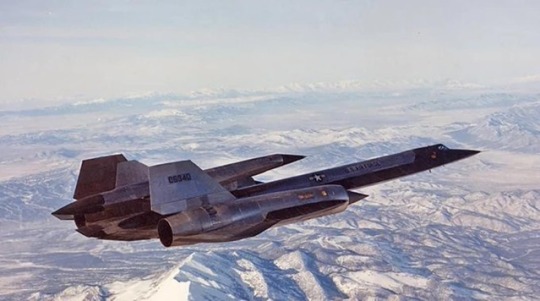
Growing up at Beale Air Force Base, CA there were black projects and then there were Deep black…. projects …I’m just finding out about many of them now.
“The goal is simple, but the problem is titanic. Get photos of the top-secret Red Chinese hydrogen bomb tests near the Mongolian border deep inside Asia, then get them back, without being detected “ to do this, they needed a MD 21. Which is a cousin of the SR 71.
In the Back Lot of the Pima Air & Space Museum You Can Discover History.
1547 Hrs. December 20, 2009. In the Back Storage Yard of the Pima Air & Space Museum Outside Tucson, Arizona.
Most of what is lying around in the dusty expanse of the aircraft graveyards around Tucson, Arizona is readily identifiable
But there… What is that strange, manta-ray shaped, dusty black thing lying at an angle just on the other side of that fence? It may be an old airfield wind vane or radar test model. But it also may be…
I quickly locate a spot where the entire fence line opens up. I skirt the fence and in a couple minutes running around the sandy airplane corpses I’m inside. There, sitting right in front of me on its decrepit transport cart and dusted with windblown sand, abandoned in the Sonoran Desert, is one of Kelly Johnson and Ben Rich’s most ambitious classified projects from the fabled Lockheed Skunk Works….
I just found the CIA’s ultra-secret Mach 3.3+ D-21 long-range reconnaissance drone. The D-21 was so weird, so ambitious, so unlikely it remains one of the most improbable concepts in the history of the often-bizarre world of ultra-secret “black” aviation projects. And now it lies discarded in the desert. The story behind it is so bizarre it is difficult to believe, but it is true.
July 30, 1966: Flight Level 920 (92,000 ft.), Mach 3.25, Above Point Mugu Naval Air Missile Test Center, Off Oxnard, California. The MD-21 takes off.
Only another M-21 is fast enough and can fly high enough to photograph this, the most classified of national security tests. Traveling faster than a rifle bullet at 91,000 feet, near inner-space altitude, one of the most ambitious and bizarre contraptions in the history of mankind is about to be tested.
Tagboard” is its codename. Because of the catastrophic May, 1960 shoot-down of Francis Gary Powers’ Lockheed U-2 high altitude spy plane over the Soviet Union the CIA and is in desperate need of another way to spy on the rising threat of communist nuclear tests. Even worse, the other “Red Menace”, the Chinese, are testing massive hydrogen bombs in a remote location of the Gobi Desert near the Mongolian/Chinese border. It would be easier to observe the tests if the Chinese did them on the moon. Flat, triangular, black, featureless except for its odd plan form as viewed from above, like a demon’s cloak, it has a sharply pointed nose recessed into a forward-facing orifice. That’s it. No canopy, no cockpit, no weapons. Nothing attached to the outside. Even more so than a rifle bullet its shape is smooth and simple. This is the ultra-secret D-21 drone. The D-21 is truly a “drone”, not a remotely piloted aircraft (RPA). Its flight plan is programmed into a guidance system. It is launched from a mothership launch aircraft at speed and altitude. It flies a predetermined spy mission from 17 miles above the ground and flashes over at three times the speed of sound. It photographs massive swaths of land with incredible detail and resolution. And because of its remarkably stealthy shape, no one will ever know it was there
Despite a successful launch the D-21 drone was lost. In the middle of 1972, after four attempts at overflying Red China with the D-21 drone and four mission failures, the program was cancelled. It was imaginative. It was innovative. It was ingenious. But it was impossible.
So ended one of the most ambitious and outrageous espionage projects in history.
Written by Tom Demerly
Posted Linda Sheffield Miller *disclaimer I did not write this I am paraphrasing.
@Habubrats71 via X
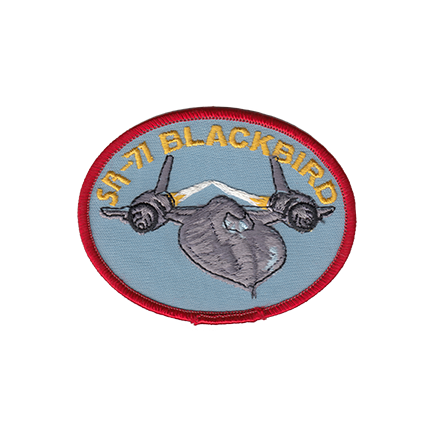

22 notes
·
View notes
Text




Myths in the Frontiers | Legends and stories of border regions
Borders are strange places a separation and contact for different countries, cultures, and people. Contraband, death, and wars, the frontiers are also habitated by shared myths, merchants, and visitors. Why wouldn't some visitors from other dimensions walk those borders too?
i. The Sonoran desert is far from inhabited. Home to many cultures since Precolumbian times and to rich fauna and flora the desert has been a place of contact between Mexico and the USA, trade, immigration and also supernatural histories regularly roam the desert. Sasquatch sightings might have been registered since the Spanish chronicles and are still common in both sides of the border, legends of ghosts abound: from La Llorona, the weeping woman looking for the children she murdered, to ghost border patrols and Chinese camps haunt the cool night. The desert's clear skies might be the reason why many ufo sightings are reported from Hermosillo, a mexican hotspot of ufos to the alien lights that supposedly were seen over Phoenix.
ii. A sacred lake from where the mythical ancestors of the Incas were born and where Uros culture built their artificial islands and developped their totora boats. The lake is still central to many indigenous cultures and to inhabitants. Close to the busy border city of Desaguadero there are many legends of the lake, from a mermaid who can kill or offer riches, to underwater cities or tunnels connectings with other worlds. A large lake with seagulls and waves, 280m deep and nestled between mountains it's bottom remain unexplored but treasures have been undercovered at times my archeologists showing the rich stories and histories of the lake.
iii. The German-French border witnessed centuries of rivalry and war but also the glory of Charlemagne's Emrpire. Where Germanic encounters Frenc Romand and Celtic tradition many stories developped. Lorelei was a mermaid turned cultural icon in the XIX century and the gold of the Nibelungs might be on it's bottom. The Rhine river was also said to have been a vast sea where vessels rooms or contain lost souls. This area is at the origins of a legend commonly know in the western world: it's near the Rhine were supposedly an underground lake contains new souls that a magical dwarf fishes with a golden net and a storks delivers to new parents.
Iv. A rare tripoint or order between three countries the Mongolian-Russian-Chinese border is full of legends. From secret soviets cities that indeed existed to the ghost of Chinese merchants haunting the mongolian mountains. The Altai mountain range, home to the Altai people of Turkic origin these peaks are said by russian stories to be place of contacts between the human and supernatural world. Modern cities and trains cross the mountains where petroglyphs tells stories about ancient herding traditions and shamans.
#legends#usa-mexico border#arizona#sonoran desert#lake titicaca#altai mountains#china#russia#mongolia#rhine river#mythology#ufos#my bad edits
4 notes
·
View notes
Text
Genghis Khan (Rider) Servant Concept
Class:Rider
Parameters Strength B Endurance A Agility C+ Magical Power C Luck A
Born Temujin, the man who would come be known as one of the greatest conquerors in all of history. He is perceived many as a great villian and butcher but to others a national hero and great leader. Among servants Genghis Khan stands shoulder to shoulder with some of the most powerful and famous heroic spirits such as Iskandar, Cu Chulainn, and Artoria Pendragon. He qualifies for many classes such as Archer, Lancer and Saber but Rider is by far his best class. In terms of fame, notoriety, and accomplishments he is without a doubt a top tier servant. Personality wise he is proud, charismatic, and larger than life. He considers himself chosen by heaven and all above to unite all nations under one banner. He is eager to experience new things and finds value in others who have skills, beliefs, customs and so on that are not his own. A man who sees only merit and character, looking beyond ones station, and seeing them for their core self. 'A wise beggar with a good heart is worth more than a king placed upon his seat through lineage alone'. Whoever is Genghis Khan's master will find a stalwart and strong servant but he will not follow there orders and may even kill them outright if he does not find them of respectable character or beliefs. He is prone to acting on his own but may take his masters council should they earn his respect.
Skills
Riding A-Genghis Khan is an expert in all vehicles and mounts, especially horses. He even has the potential to ride some phantasmal species and divine beasts.
Magic Resistance D-Can cancel out low level or single incantation spells. As well as protect from low level mental effects
Divinity C-Among the mongol people, Genghis Khan has been deified and associated with an equestrian war god known as Sülde Tngri. This deification represents Genghis Khan's martial character and the more mythical side of himself rather than the historical.
Khan Of Khans A+-A skill that represents Genghis's status as the greatest to hold the title of Khan. It is a composite skill that grants him aa high level Charisma , Tactics , and Golden Rule
Mongolian Martial Arts B-A skill that represents his expertise in the traditional martial arts and skills of his people. Such as horse archery, falconry, and Bokh also known as Mongolian wrestling, and so on. HIs skill in wrestling in particular makes him a dangerous opponent even whent totally unarmed.
Blessing Of Tengri A-It was said in the text 'Secret History Of The Mongols' that a spirit known as Zarin Tengri sent a vision from the great sky god Tengri to the Khorchin mongols, of a cow mooing toward the moon and the words 'Heaven And Earth have agreed to make Tenmujin lord of the nation'. This prophetic blessing is what allowed Genghis Khan to unite his people. It is a skill that acts similar to high ranked Protection Of The Faith and can occasionally grant prophetic dreams similar to the Revelation skill.
Noble Phantasms
Khans Grand Conquest: All Under Heaven is Mine A+ -A crystallization of Genghis Khan's ability to conquer and create the largest contiguous empire in all of history. The noble phantasm allows Genghis Khan to claim areas as his territory. The condition being that he must either win over a majority of the population in that designated area or defeat a figure of authority within that chosen area. Such as using his raw charisma to draw an entire bar to him and want to follow him, allowing him to claim the bar and the nearby area or making the mayor of a town submit to him thus claiming the town itself. Once Genghis Khan has claimed a territory as his own he has a certain level of Authority within that territory, raising his parameters slightly and allowing him to better engage any enemy that enters his territory. This skill also allows him to temporarily use the skills and even mana of others within his territory, representing the khan's propensity to incorporate other cultures, and beliefs into his kingdom rather than quashing them.
Twin White Horses: Divine Steeds Of The Khan A-The twin horses of Genghis Khan who were immortalized in a folktale. They are brothers, and are the Khan's constant companions. The older horse is white with a golden mane while the the younger is the inverse. They are similarly deified along with Genghis Khan and as such are divine beasts, representing the horse as a symbol of mongol culture. The horse and its rider are one, and it is said that the spirit or the soul is called a 'wind horse'. This association with the spirit allows the horses to ride past the veil and into the afterlife temporarily before appearing back in physical space. Though this power is extremely mana intensive. This association with the spirit world also grants them advantages against ghosts and other spiritual beings but not servants. Genghis Khan usually rides one or the other horse but they can also be summoned at the same time to pull Genghis Khan's chariot.
Khan's Tumen: Army Of The Conqueror B+-Genghis Khan had a very specific ordering of troops. He believed that a massive singular army was ineffective. And that multiple smaller armies was more efficient. This noble phantasm is a crystallization of that philosophy and allows Gengis Khan to summon a entourage of his elite Calvary up to 1000 strong. Each one of them is a minor heroic spirit in there own right and have average parameters of C. Though it is not an army as grand as Iskandar's or similar noble phantasms it has quality over quantity. However, summoning such a massive force of minor heroic spirits requires immense amounts of mana. So it is often employed sparingly.
7 notes
·
View notes
Text

Good morning! I hope you slept well and feel rested? Currently sitting at my desk, in my study, attired only in my blue towelling robe, enjoying my first cuppa of the day. Welcome to Too Much Information Tuesday.
‘Catch-22’ was rejected for publication 22 times.
The Candy Crush app makes about $850,000 per day.
Is an argument between two vegans still called a beef?
Great sex can temporarily wipe a woman's memory clean.
When the economy is better, short skirts are more popular.
Over 20,000 people have purchased alien abduction insurance.
The Champagne region of France is home to the village of Bouzy.
There's no word in the English language that rhymes with 'month'.
The Monkees’ Michael Nesmith‘s mother invented correction fluid.
The most isolated tree on Earth was hit and killed by a drunk driver in 1973.
"It's okay" and "I'm fine" are the two most common lies spoken in the world.
MTV's show ‘16 And Pregnant’ caused a 4.3% reduction in teen births in the US.
The dinosaur noises in ‘Jurassic Park’ were made from recordings of tortoises having sex.
Abraham Lincoln was assassinated on the same day he established the Secret Service.
In an early draft of Queen’s ‘Bohemian Rhapsody’ the song was titled ‘Mongolian Rhapsody’.
William Shakespeare was the first person to use insults about people's mothers.
The smell of doughnuts can increase blood flow to the genitals and stimulate an erect phallus.
About 40% of the ants in an ant colony are lazy and spend most of their time just sitting around.
85% of the world's population makes less than $200 a month. Bill Gates makes $290 per second.
85% of people have experienced a dream so real that they were not sure if it happened in real life or not.
Studies show that men who help their wives with household chores are happier and tend to have more sex.
Being dumped often leads to ‘frustration attraction’, causing the person who got dumped to love their ex even more.
In 2002, the average user spent 46 minutes a day on the internet. In 2012, that average had increased to four hours a day!
In 2011, a 46-year-old man tracked down and choked a 13-year-old boy who had been taunting him in ‘Call of Duty’.
Robert Pattinson was expelled from school at age 12 for stealing explicit magazines and selling them to his classmates.
The person that invented the stop sign, the pedestrian crossing, the traffic circle and the one-way street never learned to drive.
OMG is an acronym for a real medical condition: Oversized Male Genitalia, the technical term for men born with huge penises.
J.K. Rowling, the author of the Harry Potter series, was rejected by 12 publishers before Bloomsbury Publishing decided to publish her book.
In 1979, mathematicians David A. Cox and Steven Zucker wrote a joint paper about an algorithm that is now known as the ‘Cox-Zucker Machine’.
People who prefer Twitter over Instagram tend to be more educated, are less likely to be narcissists, but more likely to suffer from insomnia.
Eating chocolate makes you happy because it contains phenylephylamine, the same hormone the brain triggers when you fall in love.
In 2013, India's army spent six months watching what they thought were Chinese spy drones violating its air space, only to find out they were actually Jupiter and Venus.
2021's Ig Nobel Prize in medicine was given to a group of researchers who proved that having an orgasm is as effective at relieving nasal congestion as taking a decongestant medication.
When Ian Fleming’s ‘Casino Royale’ came out in paperback in the U.S., it was retitled ‘You Asked For It’, because of the fear that American readers wouldn’t know how to pronounce the word ‘royale’.
Top event names for 2024: Soul Gangbang, Soul Sewer, Crocheted Soul, Soul Stink, STS (Sexually-Transmitted Soul), Soul Toilet, Soul O, Soul Dungeon, Soul Cemetery, Soul Abattoir, Soul S, Soul Hole, and Aaah, Soul!
Richard Phillips survived the longest wrongful prison sentence in American history. He was locked up in 1972 at the age of 26 and wasn't released until 2018, aged 72. He spent 45 years in jail for a crime he didn't commit.
US states having the most sex: Top 5 States: Alaska: 2.806 times per week, New Mexico: 2.064, Vermont: 1.702, Arkansas: 1.666, Indiana: 1.531. Bottom 5: Colorado: 0.420 times per week, Maine: 0.500, Michigan: 0.511, Nebraska: 0.545, West Virginia: 0.638.
In 1186, it was agreed that the Sibylla of Jerusalem (eldest daughter of King Amalric) would become queen of Jerusalem as long as she divorced her husband, Guy de Lusignan. She agreed, on condition that she alone could choose her next husband. Once crowned, she promptly chose Guy de Lusignan.
Okay, that’s enough information for one day. Have a tremendous and tumultuous Tuesday! I love you all.
#mixcloud#mi soul#dj#music#new blog#lockdown#coronavirus#books#democracy#brexit#cronyism#election#radio#tuesdaymotivation
2 notes
·
View notes
Text
A bit of headcanon of Mongolia and Kazakhstan’s relationship dynamic:
(Maybe a bit incorrect with some details here, as I’m going to touch upon foreign policy directions and visions and while I’m trying my best it’s not my area of expertise. As it stands, this is still Hetalia headcanon most of all so pls take some details here with a grain of salt).
Basically, they are casual friends. More on the affectionate side considering their proximity to each other and their shared history/culture, but there’s a healthy distance between them. They’re very chill about this tho, they don’t exactly wish to be a lot closer because they know they can’t really help each other? Or their potential to do so isn’t explored yet?
Mongolia has a tendency to look Eastward in regards to his country’s development which is evident from the countries he’s closest to or aiming to closely befriend: China, South Korea, Japan, also US (across the Pacific). I think this is why he’s grouped under East Asian regional sphere and I bet this is quite a deliberate move from him, also affirmed by an article I once read which threaded upon Mongolian foreign policy; basically this Eastward direction is more beneficial for him economically and politically. Not just that tho; he does try to reach more countries who can help him wherever they are, but this is why he doesn’t really look toward Central Asia because the area is as much a fuckup as he is lol (and highly unstable).
Meanwhile Kazakhstan tends to look Northward and Westward/Southwestward first because this is what’s most beneficial and makes sense for him. North is Russia — like he doesn’t look toward Russia because he’s a spineless guy, he’s a pragmatic dude most of all and Russia is still stronger than him so he’s able to cooperate with him and help him with much; and especially true after he got independent is him applying Eurasian foreign policy which placed himself as a bridge between Europe and Asia. This include cooperations with Russia, former Soviet republics, and the West at large. On the Asia side he looks toward other Turkic states including his own siblings, the Middle East, and aside from that he also looks toward the East like with China, South Korea — Kazakhstan is a deeply ambitious guy and he tries to reach basically everywhere lol but as Mongolia can’t help him with much yet, he doesn’t currently have lots cooperation with Mongolia.
So Mongolia and Kazakhstan don’t have lots business with each other. Interestingly, this is what makes them highly relaxed and chill with each other tho; there’s a massive lack of tension and baggage between them. Theirs is a casual friendship forged upon a healthy distance with each other; much like how you can often end up spilling all your deepest secrets to a stranger compared to your own closest ones. Meeting each other is also in many ways like old childhood friends reuniting; as adults people have each their own business and worries with life, but when they get together they fall back on a time when things are much simpler.
Due to their high affinity in regards to culture and history, Mongolia and Kazakhstan have similar tastes about a lot of things which means they share lots similar hobbies. They’re such (mostly) different people personality wise, but when they meet together they can go on animated tangents about current developments of said hobbies. Motorcycles, cars, music (they listen to lots metal and punk/rock), outdoor activities, stargazing, wrestling (ofc), and other sports.
Overall, they have quite a lot of interest in each other but they also prefer to just observe and admire from afar. Mongolia would routinely look up news about what’s happening in Kazakhstan and Central Asia at large, and Kazakhstan too knows about current ongoings in Mongolia. This is partly technical reasons tho, because it’s best if you’re aware of your neighbors’ most current developments, but they mainly do it because they’re interested in each other.
Anyway, Mongolia is technically Kazakhstan’s grandfather but they behave as friends of equal standings. Kazakhstan respects Mongolia also because he’s technically an elder, but in a hypothetical situation where Mongolia lords over him which befits someone of a higher authority in a family setting, he will certainly not hesitate to put Mongolia in his place. How would he not, when he’s a deeply proud person as he is and he’s much stronger than Mongolia both politically and economically? But this is a hypothetical situation for a reason; it would never happen because they’re highly respectful of each other and mindful of their healthy distance.
A bit of wfsn detail: Mongolia is a chill dom with lots mentoring and guiding tendencies and Kazakhstan is a gentle top (overall) with no dom nor sub tendencies. When they get on they’re very chill and friendly, with Mongolia not much unleashing his dom side because Kazakhstan isn’t much into that; but Kazakhstan is quite a prude so there’s often some guiding from Mongolia going on, being the one more experienced.
#hetalia#aph mongolia#hws mongolia#oc kazakhstan#hws kazakhstan#my headcanon#damn this turned out long
5 notes
·
View notes
Video
youtube
চেঙ্গিস খানের হারিয়ে যাওয়া রত্নের রহস্যময় কাহিনী! চেঙ্গিস খানের ইতিহাস |...
৮০০ বছর আগে চেঙ্গিশ খানের হারিয়ে যাওয়া রত্নের রহস্যময় কাহিনী!! চেঙ্গিস খানের ইতিহাস | history of genghis khan
"চেঙ্গিস খানের হারিয়ে যাওয়া রত্ন নিয়ে এই ভিডিও আপনাকে নিয়ে যাবে ইতিহাসের এক গভীর রহস্যে! চেঙ্গিস খান, যিনি পৃথিবীর বৃহত্তম সাম্রাজ্যের প্রতিষ্ঠাতা, তার অমূল্য রত্নটি আজও একটি অমীমাংসিত ধাঁধা। কোথায় লুকানো আছে সেই রত্ন? কেন এটি এত গুরুত্বপূর্ণ? এই ভিডিওতে আমরা চেঙ্গিস খানের জীবনের বিশেষ অধ্যায়, তার সাম্রাজ্যের বিস্তার এবং হারিয়ে যাওয়া রত্নের সম্ভাব্য ইতিহাস নিয়ে আলোচনা করেছি।
ভিডিওটি দেখতে থাকুন এবং আবিষ্কার করুন, চেঙ্গিস খানের রত্ন নিয়ে চমকপ্রদ তথ্য যা আপনাকে অবাক করবে! রহস্যময় এই গল্পে রোমাঞ্চ অনুভব করতে ভুলবেন না।
🔍 ভিডিও থেকে আপনি যা জানতে পারবেন: চেঙ্গিস খানের জীবনের গল্প তার হারিয়ে যাওয়া রত্নের ইতিহাস রত্নের সাথে জড়িত রহস্য এবং কিংবদন্তি আজও রত্নের খোঁজে গবেষণা
⚡ ভিডিওটি ভালো লাগলে লাইক, শেয়ার এবং সাবস্ক্রাইব করুন। নতুন রহস্য ও ইতিহাস নিয়ে নিয়মিত ভিডিও পেতে আমাদের সাথে থাকুন।
ভিডিওর মাধ্যমে আপনি জানবেন ইতিহাসের এমন একটি অধ্যায় যা আপনাকে মুগ্ধ করবে। পুরো ভিডিওটি দেখুন এবং জানুন পৃথিবীর সবচেয়ে রহস্যময় রত্নের কাহিনী। ধন্যবাদ!
#GenghisKhan #রহস্যময়রত্ন #ইতিহাস #মঙ্গোলসম্রাট #চেঙ্গিসখানেরগল্প
চেঙ্গিস খান, চেঙ্গিস খানের রত্ন, মঙ্গোল সাম্রাজ্য, ইতিহাসের রহস্য, হারানো রত্ন, চেঙ্গিস খানের সমাধি, রহস্যময় ঘটনা, মঙ্গোলিয়ার ইতিহাস, প্রাচীন ধন, রহস্যময় রত্ন, অমীমাংসিত ধাঁধা, চেঙ্গিস খানের গল্প, Genghis Khan, Genghis Khan’s treasure, Mongol Empire, lost treasure, historical mystery, Mongolian history, unsolved mystery, ancient treasure, Genghis Khan’s tomb, mysterious gem, legendary treasure, historical secrets
0 notes
Text
BIOGRAPHY : YONE

▲ 𝐵𝐴𝑆𝐼𝐶𝑆 ▲
➢ 𝐍𝐀𝐌𝐄: Yone ➣ 𝐒𝐓𝐀𝐓𝐔𝐒: @essencefluxed ( multiship ) ➢ 𝐀𝐆𝐄: 29 ➣ 𝐆𝐄𝐍𝐃𝐄𝐑: genderfluid ➢ 𝐒𝐄𝐗𝐔𝐀𝐋 𝐎𝐑𝐈𝐄𝐍𝐓𝐀𝐓𝐈𝐎𝐍: bisexual ➣ 𝐇𝐄𝐈𝐆𝐇𝐓: 5'11 ( approx.: 180.34cm ) ➢ 𝐖𝐄𝐈𝐆𝐇𝐓: uncomfirmed ➣ 𝐇𝐀𝐈𝐑 𝐂𝐎𝐋𝐎𝐔𝐑: white with red streaks ➣ 𝐄𝐘𝐄 𝐂𝐎𝐋𝐎𝐔𝐑: green ➣ 𝐁𝐈𝐑𝐓𝐇𝐃𝐀𝐘: august 6th ➢𝐓𝐈𝐓𝐋𝐄(𝐒): BAND MOM, BAND PRODUCER ➣ 𝐒𝐏𝐄𝐂𝐈𝐄𝐒: human ➣ 𝐒𝐎𝐍𝐆: SHADOW OF MINE -- ALEC BENJAMIN
▲ 𝐏𝐄𝐑𝐒𝐎𝐍𝐀𝐋𝐈𝐓𝐘 ▲
though yone may appear somewhat cold and difficult to approach, he's actually rather warm once you get to know him. he's strict because he has to be or the other band members won't stay in line -- however, anything and everything he does is always for their sake. he dearly loves his band members, and works himself to the bone to see them all succeed. he keeps others at a distance for personal reasons, and seems to carry an unspoken burden on his shoulders. he can, on rare occassion, be playful and even lackadaisical, but the moments don't last too long. behind his frozen exterior is a man who loves deeply, who cares deeply, and would do anything for those closest to him.
▲ 𝐍𝐎𝐓𝐀𝐁𝐋𝐄 𝐃𝐄𝐓𝐀𝐈𝐋𝐒 ▲
white hair with streaks of red it in, usually pulled back in a ponytail. seen carrying two swords, though nobody's sure why. they just don't question it: rich people can do what they want. typically wear's modest and form-fitting clothing. there is a scar over his left eye. sometimes he dyes his hair blue and gold..
▲ 𝐋𝐈𝐊𝐄𝐒❓ silence, working, his band members NOT acting like a circus, cold brew coffee, designing new beats, cleanliness and order, animals -- especially dogs and cats, houseplants, his younger brother yasuo.
▲ 𝐃𝐈𝐒𝐋𝐈𝐊𝐄𝐒❓ when kayn and ezreal break shit -- when they're loud in general, arguing, overly greasy foods, his hair being a mess, his clothes being a mess, just generally having a poor appearance.
▲ 𝐒𝐇𝐎𝐑𝐓 𝐁𝐈𝐎𝐆𝐑𝐀𝐏𝐇𝐘 ▲
the history behind Yone is a well-kept secret, even from his own brother. while it's well known that he was a half-mongolian, half-Japanese, Japanese-born citizen, there are aspects of his childhood that are... a mystery. for one, when Yone was about eight years old, he mysteriously drowned in a river that he and his brother Yasuo were playing in. when Yasuo saw his older brother suddenly disappear and not return to the surface, he panicked and ran off to get their father. though when the two returned, Yone was sitting on the edge of the riverbank, seemingly unharmed. what was even more strange was that Yone was an excellent swimmer. he and his brother had been playing at that river for years, so it was odd that he would suddenly be unable to swim and drown. their father wrote it off as Yasuo just telling tall-tales as Yone appeared to be fine, and even denied drowning. this had caused a slight rift to grow between them, but it only grew exponentially when their parents mysteriously died. at that time, their father was already married to Yasuo's mother -- making her Yone's step-mother, but she loved him like he was her own son. the two boys had grown up in a happy household until the moment their parents were murdered. Yasuo believes Yone knows who or what killed them, but refuses to tell him. this created conflict between the two of them, and they went their separate ways. for a while Yone was an underground DJ, using music to vent his sorrows, but even that fell off over time. at one point he convinced himself he'd never make music again, but after meeting the other members of HEARTSTEEL, his tune gradually changed. it took some coaxing from both Sett and K'sante, but eventually Yone would take on the role of band producer and help lead the group into the spotlight, all while concealing the darkest and well-kept secrets of his sorrowful past.
images below the cut



1 note
·
View note
Text
Tuva
Name: Aydyn Kuular
Tuva/the territory of what is now Tuva has been ruled by other major empires throughout his lifetime, ever since the Xiongnu era. (209BC - 93AD) After the Xiongnu, it was the Xianbei, the Rouran Khaganate, the Gokturks, the Tang Dynasty, the Uyghur Empire, the Mongol Empire, the Yuan dynasty, the Northern Yuan, the Khogtoid Khanate and Zunghar Khanate, then the Qing. However during the Qing, Tuva was administered by Mongolia.
Some facts
"Dubo" first appears in Chinese records.
Tuvans then were known as "Dubo" (later pronounced as Tuva but also in other forms they were called Toba/Tuba/Tyva/Dyva/Tofalar). They lived in isolated groups in grass tents, ate lily roots, fish, birds, and animals, and wore clothing made of sable and deerskin. Some of the wealthier individuals had horses, but herding was not common. When someone passed away, they would perform a "sky burial" by placing the deceased in trees.
Ruled by Turkic Empires, the Tang, the Uighur Empire, the Mongols
Reappearance of "Tuba" in the Secret History of the Mongols (The Mongols called Tuvans forest people/put them in the forest people category): 13th and 14th centuries
Conquered by the Khotoghoi Kalkha in the 16th and 17th centuries
Passed into the hands of the Zunghars (Mongolic people but not Chinggisid/Khalkha Mongols) in the 1660s (so Mongolia and Tuva would mald about the Zhungars/Oirats together)
Fall of the Zunghars to the Manchu Qing Dynasty in 1755
Tannu Uriyangkhai organised as an aimag (province) in the 18th century under Mongolian rule
Tuva's adoption of Buddhism in the 18th century
Tuva had 5,000 lamas in 30 monasteries and 1,000 shamans in the 1920s
I think that the Tuva we see today was born during the Tang Dynasty era, and the previous personification of "Tuva" or Tuva's ancestor fell during this time. This is because emperor Taizong of Tang sent troops to get rid of the ethnic minorities of Xue Yanto. Now, Xue Yanto used to be an ancient Khaganate in Northeast Asia who used to be the allies of the Gokturks. The Xue Yantuo was a member of the Tile tribe which belonged to the Turks until 583 when it broke into Western and Eastern branches. However they then allied with the Tang against the Eastern Turks. It was vast and it included (what is now) Tuva in it.
The Xue Yantuo and Tang were friendly for a bit, however it changed in 639 with emperor Taizong's actions, and this is when their relationship began to worsen. Ashina Duobi of the Eastern Turkic Khaganate was captured, and Emperor Taizong placed the surrendered Eastern Turks within the borders of the Tang without appointing a new Khan to manage them. However after Ashina's nephew conspired to rebel against the emperor, he then changed his mind and gave the title of Ashina Simo (Eastern Turkic aristoricrat) to the Tang Dynasty, appointing him as the new Eastern Turkic emperor.
Ashina Simo settled in Dinxiang (now Hohhot, Inner Mongolia) in 641. Yinan, who was the Khan of the Xue Yantuo, saw this as an opportunity to launch an attack on the Eastern Turks before the Tang could assist them. Ashina then asked for urgent assistance from the Tang, and they provided. Afterwards, funnily enough, Yinan sent an envoy to tell emperor Taizong that he was willing to live peacefully with the Eastern Turks (lol trying to save face much?). Emperor Taizong sent an envoy back to criticise Yinan but didn't take any further action against the Xue Yantuo.
Sensing that the relationship between Xue Yantuo and the Tang was turning sour, Yinan tried to amend relationships through tribute and intermarriage, however even then there was issues (Emperor Taizong making excuse after excuse to cancel or postpone Yinans marriage to Princess Xinxing, his daughter). Since then, relationship could not be repaired.
After Yinan died, the Xueyantuo descended into chaos. Two of his sons ruled the Xue Yantuo, Bazhuo ruled the West, and Ye Mang, the East. Bazhuo killed Yemang, and ascended fully to the throne, deciding to attack the Tang. He suspected that the Tang border would be unguarded at the Tang were invading Goguryeo, however Emperor Taizong predicted that this would happen. In 646, Emperor Taizong stationed more troops against Bazhuo's attacks. Bazhuo was defeated in the same year.
Bazhuo was a pretty bad leader, and instead of appointing his father's ministers to assist him, he replaced them with his own cronies, causing disarrest among the nobles and eventually causing a rebellion against him. Huihe, he was a vassal of the Xue Yantuo, was a main rebel against Bazhuo.
Seeing all of this chaos take place, emperor Taizong launched an attack on the Xue Yantuo, and the people of the Xue Yantuo panicked, including Bazhuo, who then fled to the Ashide tribe. Huihe, upon hearing this, killed Bazhuo and the remaining royal family members of the Xue Yantuo. After Huihe took most of Xue Yantuo's territory, most of the people of the Xue Yantuo surrendered to the Tang. However some still did try to hold on, and saw Yinan's nephew Tumozhi as the new Khan of the Xueyantuo. However of course, the Tang did not recognise this, and emperor Taizong sent troops to attack the Xue Yantuo, and Tumozhi surrendered. The Xueyantuo then collapsed. Now, the Tuvans paid tribute to the Tang, and they established a monarch-subject relationship. I don't think Tuva was born as soon as the Xueyantuo collapsed but he was young when he experienced the downfall. He's a similar age to Mongolia.
So, that was my long drawn out explanation of when I think the we see now Tuva was "born".
TL;DR, during the Zhenguan period of the Tang Dynasty (Emperor Taizong period) when the Xue Yantuo confederation was destroyed and when the the territory of Tuva/Tuva paid tribute to the Tang, was an approximate date of when Tuva was "born." I think he most likely emerged a century or so before this as of course he wasn't born as soon as the Xue Yantuo collapsed or something, but he was young when he witnessed it's downfall.
Random fact, but in the Tang Dynasty era book "Tongdian", the Tuvans were described as "skiing hunters", and during the Yuan, the Mongols called them the "forest people"/ put them under the "forest people" category.
Tuva, as I have said before, was conquered pretty easily throughout his lifetime. Skipping to the Mongol Empire era, it was conquered by the Mongols in 1207 by Jochi, Chinggis' eldest son. The Mongols then established suzerainty over them. It was ruled by Khalkha Mongols until the 17th century, when they then were ruled over by the Oirats Mongols and were a part of the Dzungarian state. So, for a long time, Tuva was ruled over by Mongols/Mongolic people. For this reason and because of the many cultural similarities between the two, he feels pretty relaxed around Mongolia. Furthermore, during the Qing, although Tuva was a part of China, it was administered by Outer Mongolia. Tuva used to be a part of Mongolia.
In 1911, Mongolia regained its independence back from the Qing. Some regions of Tuva like Tozhu, Salchak, and Khöwsgöl banners wanted to be part of Mongolia, while only the Tannu banner leader appealed to Russia. In 1914, what is now Tuva became part of Russia due to Russian settlers moving in.
However, in 1914, the Russian empire made Tuva its protectorate and allowed Russians to settle there. However even before then, Russians were already settling down in Tuva in the 19the century. In 1860, the Qing signed a treaty with Russia that Russians were allowed to live in Tuva, as long as it was in boats or tents, however by 1881 they were already living in permanent homes. This was the beginning of the Russian colonisation of Tuva, however 1885 was the year of official colonisation of Tuva when the Governor-General of Irkutsk gave permission to a merchant to farm at present-day Turan. From this, more settlements formed. There were around 2000 merchants and colonists by the first 1910's.
This greatly offended the Tuvans and there would be fights between them and the Russians from time to time.
The Qing weren't oblivious to this and were concerned at first, but eventually, internal problems with the Qing meant they didn't have enough time to focus of Russia creeping in on Tuva.
In the 20th century, Tuva was broke asf, their economy was in shambles and there was an increase of poverty in the region, thanks to Russia. The Qing established a rule that Han traders were not to trade in Tuva, and this rule was actually applied, unlike what happened in outer Mongolia. However, Han traders were then allowed into Tuva to compete against the monopoly the Russians had over there, and eventually, like what happened in outer Mongolia, the Chinese dominated commerce there. Many Tuvans found themselves indebted to Han merchants.
I don't think Tuva is some sort of peeping violet, yes, Tuva was ruled by many empires during his life but he is still a proud person who values freedom, and isn't one to completely just bow down. He is moreso someone who just wants to mind his own business, and if (begrudgingly) paying tribute means he'll be left alone for the most part, he'll take it.
Furthermore during the end of the Qing reign of Tuva, when the Wuchang uprising of October 10th 1911 led to a full scale revolution. Mongolia declared its independence from the Qing in early December, and during the second half of December, the Tuvans plundered many Han owned businesses, calling back before to when I mentioned how Tuvans would fight Russians who settled down in Tuva lol. Tuva definitely isn't one to go down without a fight and is quite fierce-willed despite his quiet exterior and history.
In 1921, pro-Soviet Russians took control during the Russian Civil War, and Tuva became a people's republic. By 1926, it had a population of around 58,117 Tuvans and 12,000 Russian settlers. Initially, Mongolian was the official language, and Tuva wanted union with Mongolia, but Mongolia, under pressure, recognised Tuvan independence in 1926.
Explaining Tuvan independence further, jumping back to when I said the Russians declared Tuva as its protectorate in 1914, the new communist Russian government of 1921 declared that this was invalid, so technically, Tuva was an independent state (under very heavy Russian influence/was essentially a puppet state.)
From 1930-31, Tuva underwent changes, including the introduction of a new Latin script for Tuvan. However, attempts at collectivization failed, and pro-Mongolian Tuvan politicians faced execution.
During World War II, Tuvans were conscripted into the Soviet Red Army, and in 1944, the Soviet Union annexed Tuva as an autonomous region within the Russian Soviet Federated Socialist Republic, .allowing Russians to enter Tuva to work in mines and factories. A Cyrillic script for Tuvan was introduced in 1943, and collectivization continued until 1954.
In 1961, Tuva became an Autonomous Soviet Socialist Republic within the RSFSR. The percentage of ethnic Tuvans increased over the years. After the Soviet Union's dissolution, Tuva became a constituent republic of the Russian Federation. In 1989, there were 198,448 ethnic Tuvans, making up 64 percent of the republic's population, and border transit points with Mongolia were opened, though issues like livestock theft and unauthorised pasturing persisted.
Because of Russian colonisation, the identity of the Tuvan people was hurt greatly. Before, they were able to freely live as nomads, hunt, practice shamanism, use their traditional medicines. But after Russian colonisation, forced assimilation, forced settlements, the Tuvan identity was scarred. Despite this, Tuvans resisted full Russification.
Russia kept Tuva closed off from the outside world for nearly 50 years. Even now, Tuva is remote and difficult to access, and is one of Russia's poorest regions. This is why Tuva comes off as closed off/aloof.
Tuva does feel a bit on edge when interacting with other nations who he doesn't feel close to, primarily because of the period of isolation he was put through under the Russians, and he can come off as a bit aloof. He's quite friendly really and he does want to make more friends, he just finds it hard to trust people. For this reason he's lucky he has a cute face to make up for the moody exterior.
He also talks to Yakutia/Sakha about whatever, their conversations are not usually that deep though.
Tuva is trying hard to reclaim his national identity, for example, after the fall of the soviet Union, ethnic Tuvans living in Tuva went up from two-thirds to three-quarters of the population. He's extremely keen on having the lowest amount of contact with Russia possible outside of what's necessary lol.
He probably blasts Huun-Huur Tu and Sainkho Namtchylak.
He and Mongolia, despite their familiarity with one another, do have a bit of a... Rivalry going on about where throat singing originated and who's better haha.
Anyways that's my Tuva. His name is Aydyn Kuular and overall personality wise he is:
Seemingly quiet/aloof
On the inside, quite fierce willed
Very much "I mind my own business, you mind yours."
Is actually quite warm once you get to know him but it's hard for people to get to that point
Avid music lover and is always composing something new!
Tries to reach out to others the best he can
Not a fan of Russia or China
Has his own little projects, doesn't tell a lot of people about them though
#hetalia#Hetalia oc#Historical hetalia#hetalia world stars#hetalia world series#hetalia world twinkle#Hetalia headcanons#Hetalia Asia#Aph Asia#Hws asia#Hws#Aph#Aph tuva#Hws tuva#Hetalia tuva#OC: Tuva#OC: Aydyn Kuular#hws mongolia#aph mongolia#Hetalia Mongolia
30 notes
·
View notes
Text
ROUND 2, MATCH 2
Admin's commentary: I don't think this one is going to be particularly tense, I am just waiting for the match 1 of the next round, which is going to be SPICY.
***
WHAT MY PROFESSOR OF MEDIEVAL HISTORY SAID ABOUT THEM
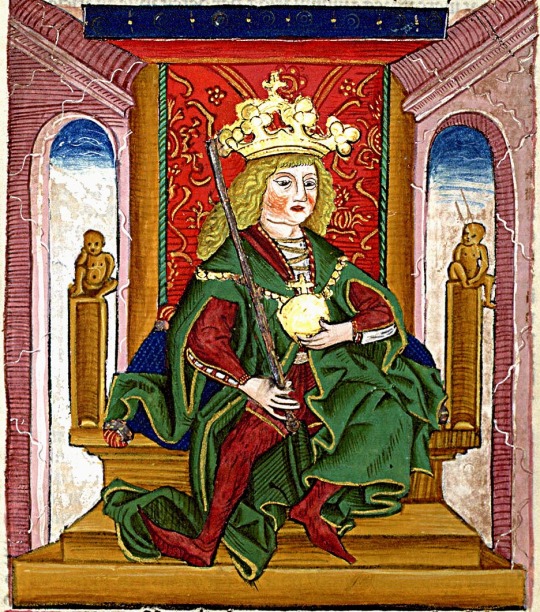
I.Béla (Belo I.) 1060-1063
stole the throne from his brother, who died in battle with his forces, which is a dick move, but also honestly typical Arpád dynasty behavior
during his reign, there was a pagan uprising apparently?
he ordered that town markets be held on Saturdays instead of Sundays (something something christianization or whatever, honestly this is like his most lasting contribution to Hungary and it's not even close)
he divided duchies of Nitra and Bihár between his sons or something, honestly I don't care and neither should you
he apparently died when his throne collapsed under him, no I am not making this up and no I don't know why, I am just reporting what our professor said I swear-
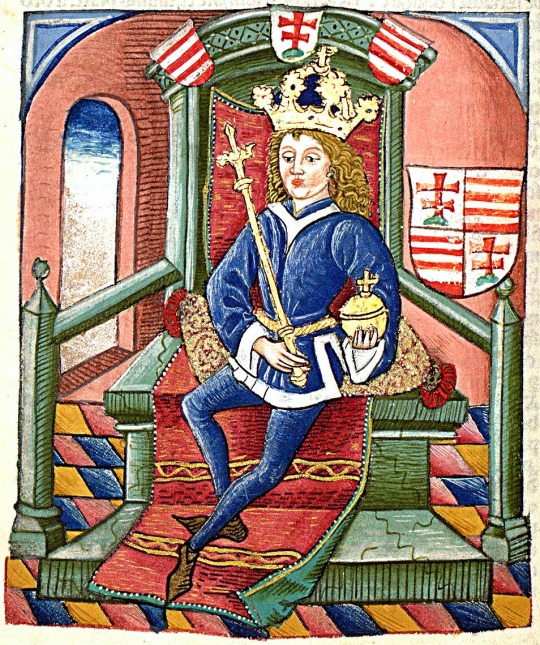
I.Lajos (Ľudovít I.) 1342-1382
ruled for the impressive 40 years and spent 30 of it in war - around Neapolitan succession (don't ask, it's High Middle Ages, Angevins are EVERYWHERE), invasion of Wallachia, against Venice, crusade against Lithuanians, fending off Mongolian invasion of Moldavia
but I guess that's what happens when you have a country at its peak - you can afford to go to wars; to be fair, his dad already took care of the whole "consolidation" part of the process, so he could get into the expansion, during his reign Hungary at its peak extent territorially
founded the first Hungarian university in Pécs
made some minor provisions to the Golden Bull, namely forbidding the kidnapping and forced relocation of peasants by nobility
made important administrative reforms, like founding of the Secret Chancellory
also king of Poland, @rulers-of-poland-tournament said about him: "Lajos, or Ludwik Węgierski is often held responsible as the ruler who begun the tradition of Przywileje Szlacheckie - those being economic or judicial privileges of the nobility granted in exchange for loyalty. in the long term they led to drastic inequalities and ineffectiveness of royal power, but of course, Ludwik could not have known what he was laying the groundwork for"
@majowajutrzenka said about them: "He recognized his daughters as heirs to the thrones. He also have nickname the great. He wonderful king, son, husband and father. He familly dude. Lajos declared war on Charles of Luxembourg, when he insulted his mother (Elizabeth of Piast, big sister Casimir the Great)"
4 notes
·
View notes